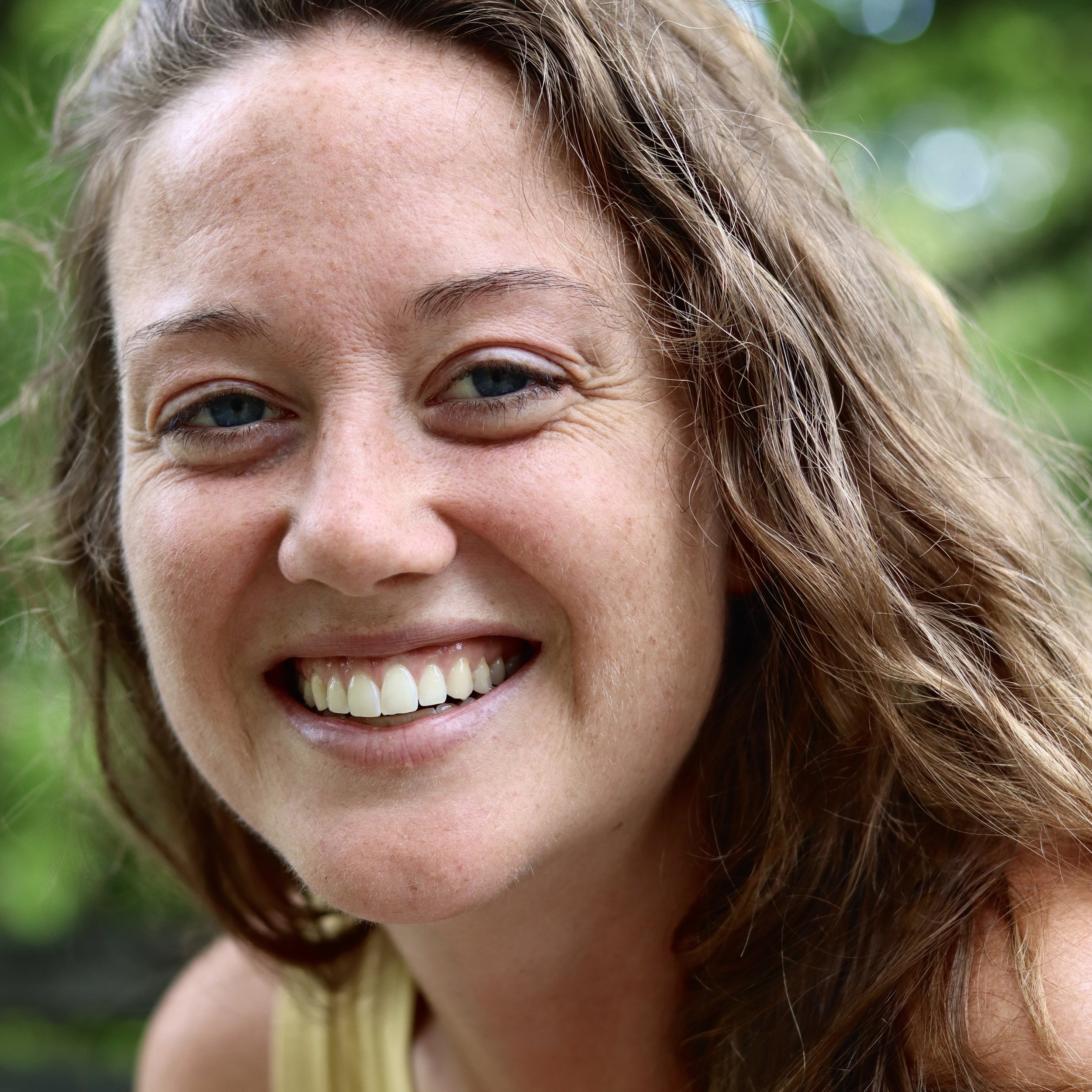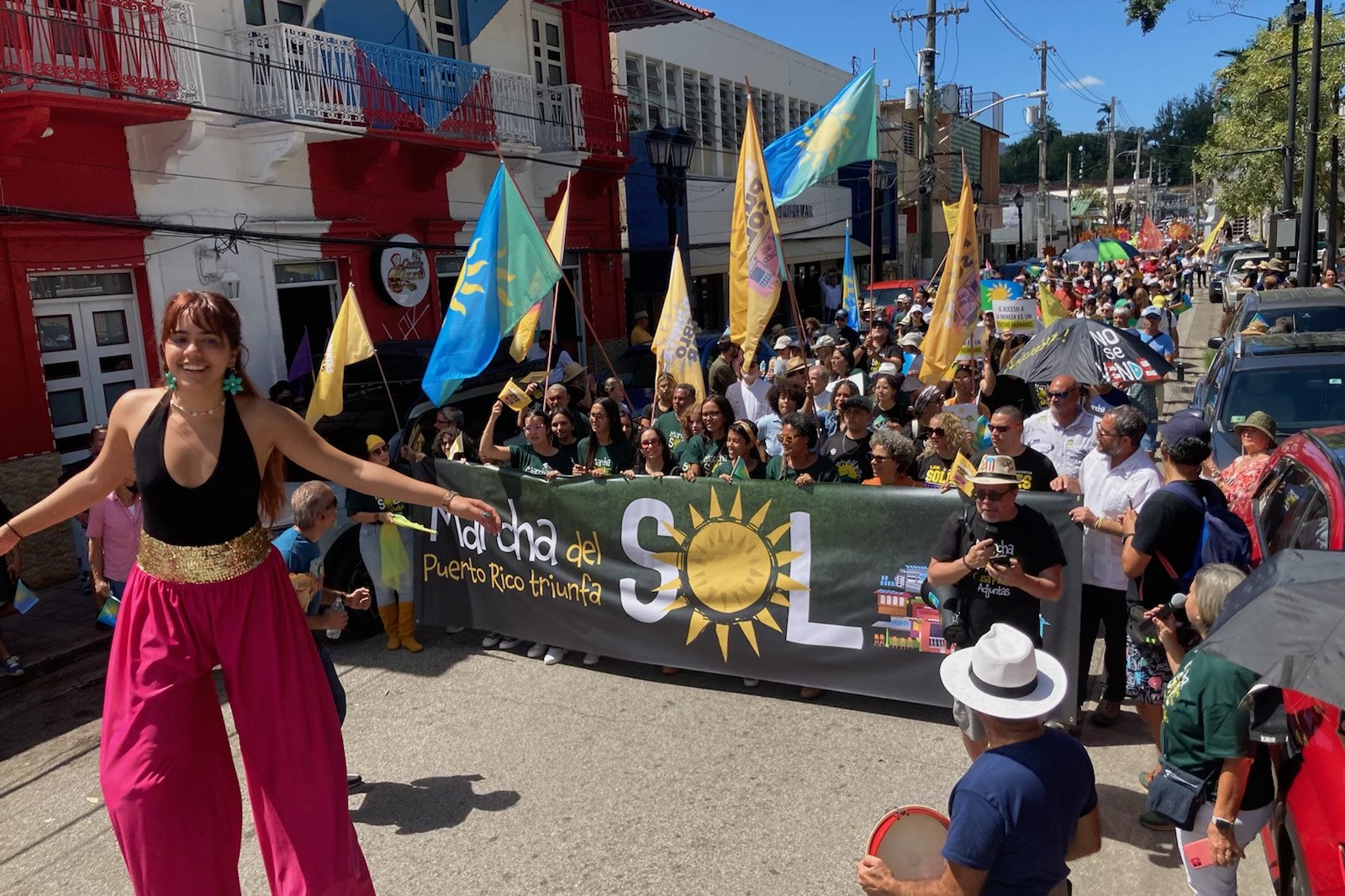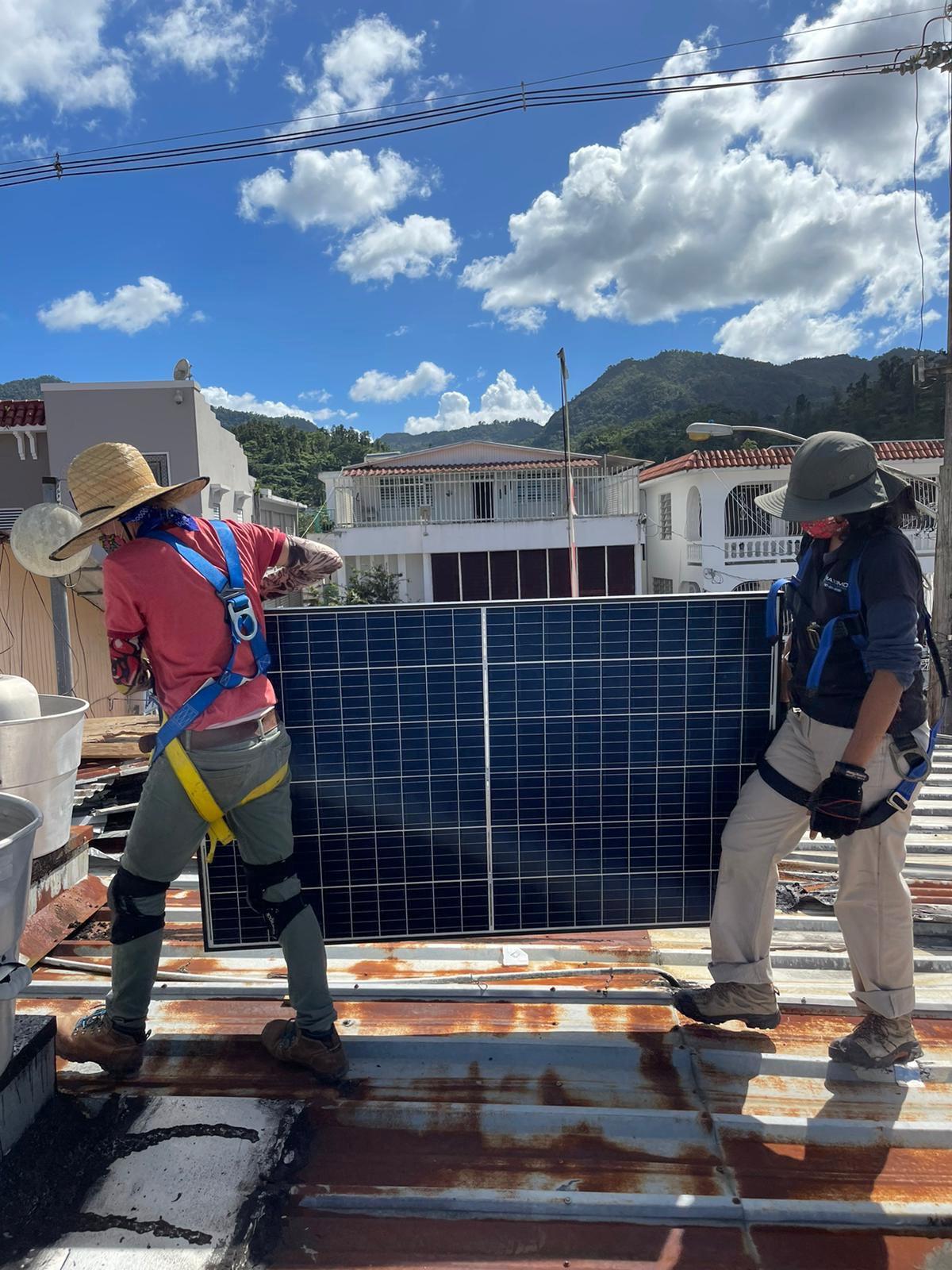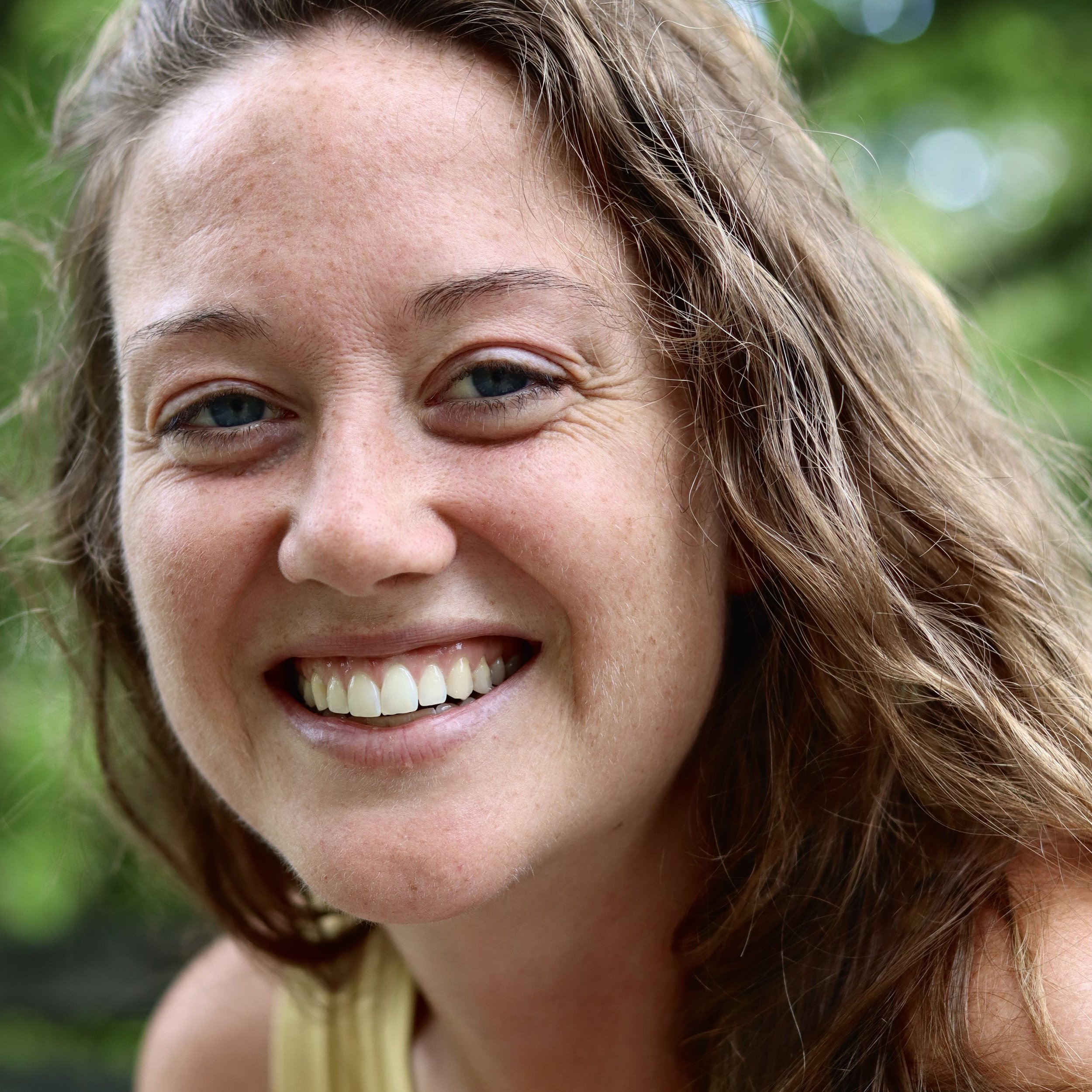An Island in Search of Light
As a co-owner of the new solar microgrid, Lucy’s Pizza owner Gustavo Irizarry expects to save enough money on energy bills annually to hire two additional employees. Photo by Katherine Rapin
Residents in Adjuntas, Puerto Rico, have built the island’s first community-owned solar microgrid
This article originally appeared in Nexus Media News and Next City as part of a series that looks at how cities are tackling inequality and the climate crisis. The Spanish-language version of this article, was translated by Patricia Guadalupe and produced by palabra.
Haga clic aquí para leer el reportaje en español.
For two weeks after Hurricane Maria devastated Puerto Rico in 2017, Lucy’s Pizza was the only restaurant open in the central mountain town of Adjuntas. The town’s 18,000 residents, like those on the rest of the island, were entirely without electricity.
“No one has power, you can’t get gas, it’s difficult to make food, so everyone came here to eat,” said owner Gustavo Irizarry. “The line,” he gestured down the block along the town’s central plaza, “endless.”
Using a diesel generator, Lucy’s was running at about 75% capacity. The generator was loud, smelly and expensive to run — Irizarry spent $15,000 on diesel in the six months the grid was down. He was often up in the middle of the night to restart the generator because of the risk of losing power to the refrigerators. He didn’t want ingredients to spoil.
Now, nearly six years later, Irizarry is poised to generate his own energy from the sun. He’s one of 14 merchants in downtown Adjuntas who have invested in the island’s first community-owned solar microgrids — expected to go live this summer.
“After Maria, we saw the vulnerability and the necessity to have an electric system that truly works,” Irizarry said. “To have better, alternative power, to be able to live.”
The microgrid project is the latest effort in a grassroots movement to build energy security in Puerto Rico in the form of solar power. Across the island, groups like Casa Pueblo, which first opened in Adjuntas more than 40 years ago, have relied on deep roots in the community to create local buy-in and make it an equitable transition.
In March 2023, thousands of people took the streets of Adjuntas for Casa Pueblo's second annual gathering in support of solar energy. Photo by Katherine Rapin
“The microgrid is a major step in taking Puerto Rico from the vulnerability of the centralized fossil fuel system to the aspiration that I think we share in Puerto Rico,” said Arturo Massol Deyá, associate director of Casa Pueblo. “To use (renewable) fuels and generate power at the point of consumption, where it’s needed.”
Microgrids power small networks of buildings with energy that’s generated close to where it's used, often wind or solar. The systems are typically connected to a central grid, but in the case of an outage they can run on “island mode,” relying solely on locally-generated power and battery storage capacity.
Hurricane Maria damaged 80% of Puerto Rico’s power grid, and the subsequent outages, which lasted for months, contributed to the storm’s death toll. Six years and $14 billion in federal commitments later, Puerto Rico’s central grid is still in disrepair.
Puerto Ricans suffer regular outages while spending, on average, 8% of their incomes on electricity, according to the Institute for Energy Economics & Financial Analysis (IEEFA). (The average American spends 2.4% on electricity.)
“It’s not an opportunity to move away from the centralized system,” said Massol Deyá. “In Puerto Rico, it’s a necessity.”
The U.S. Department of Energy's Oak Ridge National Laboratory, researchers are developing architecture and algorithms to make Adjuntas' microgrids more reliable and resilient. Photo by Carlos Jones, Dept. of Energy/ORNL
Puerto Rico’s energy problems predate Maria. The island’s utility, PREPA, had filed for bankruptcy in March 2017, nearly six months before Maria. In 2020, officials signed a 15-year contract giving LUMA Energy, a consortium of Canadian and U.S. companies, control over the transmission and distribution of electricity. Since LUMA took over, rates increased and blackouts have continued. (LUMA did not respond to requests for comment.)
Renewable energy advocates, including the movement Queremos Sol (We Want Sun), say the solution is obvious. Rooftop solar alone could provide four times the island’s residential energy demand, Department of Energy studies have shown. In 2019, Puerto Rican lawmakers set a goal of transitioning to 40% renewable energy by 2025 and 100% by 2050. But despite those commitments, the island currently sources less than 4% from renewables. In recent years, PREPA has advanced methane gas projects and even proposed a fee on energy generated by rooftop solar to help pay its $9 million debt.
“It’s the worst thing that could happen to Puerto Rico,” said Massol Deyá of a potential solar tax. (PREPA did not respond to requests for comment.)
For Massol Deyá, the outages following Maria were a tragedy — but also a chance to extoll the benefits of solar power. In the wake of the disaster, Adjunteños gathered at Casa Pueblo, which had installed its first solar panels in 1999 and had gone off the electric grid entirely just months before Maria. Locals were able to charge phones, run dialysis machines, and store medications in the center’s refrigerators. One neighbor came daily to administer her son’s asthma treatment.
Located in the central mountains of Puerto Rico, Adjuntas is becoming a global model for its equitable transition to so-called clean energy. Photo by Ricardo Arduengo
Members of Puerto Rico’s diaspora got in touch with Casa Pueblo to ask how they could help. “We told people, we don’t want money — send us solar lamps,” Massol Deyá said.
Over the next six months, the organization distributed 14,000 lamps. And in the last six years, it has helped fund and install more than 350 solar energy systems on buildings across town, including in an assisted living facility, a grocery store, the local fire station and many homes in the poorest neighborhoods of Adjuntas. Casa Pueblo even built a public solar park, where locals charge phones using outlets that source energy from solar arrays resembling trees.
In 2018, Salt Lake City-based Honnold Foundation, which supports solar projects around the world, took notice of what was happening in Adjuntas. Then-director Dory Trimble reached out. “She told us to think bigger,” said Massol Deyá. “(We thought) why not do downtown Adjuntas, around the main square, which is what gives communities in Puerto Rico a sense of identity?”
Lucy’s is in one of seven buildings around Adjuntas’ central plaza connected to two half-megawatt battery storage systems that link to the central grid; in the case of an outage, the systems can “island,” relying on their own generation and storage.
By creating a microgrid with other local businesses on the grid, including a bakery, hardware store and pharmacy, Adjuntas could gain energy security during emergencies, all while starving the fossil fuel industry by unplugging those with the highest energy demands.
But as the microgrid idea was taking shape, Casa Pueblo’s late co-founder Tinti Deyá Diaz (Massol Deyá’s mother) said she wanted to ensure that lower-income residents would continue to benefit from the solar transition — after all, households with solar power were paying about $40 less per month on their energy bills, according to Casa Pueblo.
Based in Puerto Rico, Máximo Solar hired local women to help install the 700 solar panels that power the microgrid. Photo courtesy of Casa Pueblo
That concern led Irizarry and the 13 other investors in the microgrid to form the Community Solar Energy Association of Adjuntas (ACESA), a non-profit independent utility that reinvests in community solar projects, prioritizing homes of the most vulnerable Adjunteños. “We each have a commitment to the community,” said Irizarry.
Their dedication paid off. When Hurricane Fiona hit in 2022, it caused widespread outages, but the town’s solar-powered buildings were spared. The local fire station became a regional response center, intercepting calls from a station in Ponce, 15 miles to the south, which had lost power.
“When you see the entire landscape, you know that we are still at risk — we are going to be confronting the same climate change challenges, hurricanes, earthquakes,” says Massol Deyá. “But we are in a better situation for normal days and we’re better positioned to confront difficult times as a community.”
Adjuntas’ transition has earned it nationwide recognition. In March, Secretary of Energy Jennifer Granholm visited Casa Pueblo to discuss plans to disburse $1 billion in federal funds to improve Puerto Rico’s grid. (The Puerto Rico Energy Resilience Fund, approved by Congress in December, will focus on the island’s “most vulnerable and disadvantaged households and communities.”) Following her visit, Granholm tweeted, “They're leading by example, showing that 100% solar power is possible for Puerto Rico.”
Other communities on the island are interested in replicating Adjuntas’ model. The Monte Azul Foundation is working to develop a solar microgrid in Maricao, 30 miles west of Adjuntas. Last March, director Andrew Hermann visited Adjuntas with Maricao residents.
“Seeing (the microgrid) in person and talking to business owners that are super pro-microgrid — it's really assuring the business owners here,” Hermann said. “That's the type of energy that helps build these projects from the ground up.”
—
Katherine Rapin is a freelance climate journalist based in Puerto Rico. Her work has been published by WIRED, Yes! Magazine and Yale Environment 360 among others. She's currently focused on stories about climate adaptation, resilience and humans restoring relationships with the natural world. Read more at KatherineRapin.com.







